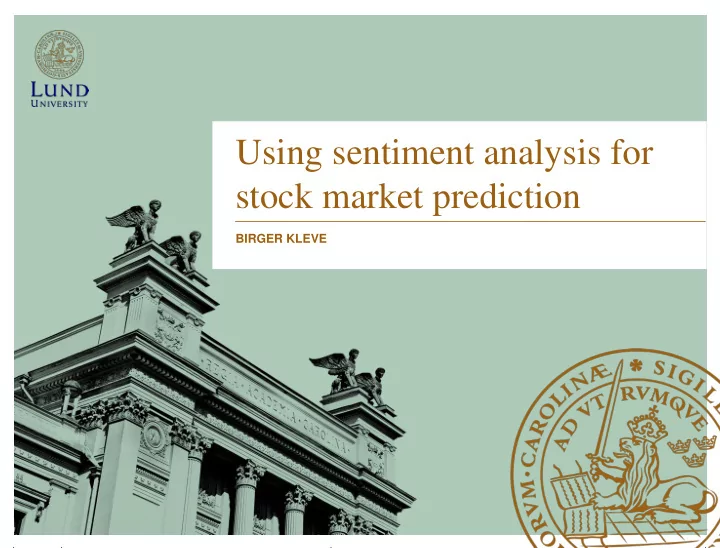

Using sentiment analysis for stock market prediction BIRGER KLEVE
Project Goals • Increase Machine Learning knowledge – Learning real world practice – Facing real world problems – Optimize algorithm parameters
Project Definition Hypothesis: There is a correlation between tweet sentiment from certain people and a stocks movement. System: 1 Find tweets mentioning stocks 2 Classify sentiment of the tweet 3 Predict stock movement by processing stock data and tweet sentiment
Availability of Financial data on Twitter
Project Redefinition • Drop the financial aspect of the project and only focus on the sentiment of tweets
Sentiment Analysis • Keyword spotting – E.g. Happy, sad, bored • Lexical affinity – Affinity (swe: samhörighet) to a certain probability of polarity • Statistical methods • Concept-level techniques – Semantic analysis of text Cambria, E. An introduction to Concept-Level Sentiment Analysis. National University of Singapore
Pang & Lee • Thumbs up? 2002 • Movie reviews • Presence of Unigram + Bigram w/ negation Pang, B. Lee, L. Shivakumar, V. Thumbs up? Sentiment classification using Machine Learning Techniques. Cornell University, IBM Almaden. 2002
Social Media Features • Words entirely in caps • Prolonged words like angryyyyy • Positive/negative emoticons • Amount of hashtags • Frequency of different POS tags
Sentiment lexicon • Look up each word in a sentiment lexicon. • Lexical affinity • Use Features: – Highest score – Total score – Mean score
Tokenization and negation • Change usernames, URLs, hashtags etc. into normalized tokens • Tag certain words with negation. E.g. ”This horse is not that bad” => ”This horse is not that_NOT bad_NOT” ”not quite as great” => ”not quite_NOT as great” • Use the presence of each unigram as a feature
Classifier • SVM with Linear kernel • Parameters: C
Training • Tokenize and collect each unique word in the training data and save it as a vocabulary. • Fit SVM to the entire training set • Optimizing parameter C – 3-fold Cross Validation – Grid Search – Test the final classifier against a separate test set
Data • Training set 1 600 000 automatic classified tweets – w/ Keyword search – 2 classes: Negative & Positive • Test set 357 manually classified tweets Go, A., Bhayani, R., & Huang, L. Twitter sentiment classification using distant supervision. Tech. rep., Stanford University, 2009. • Sentiment lexicons: – Lexical affinity Kiritchenko, S., Zhu, X., Mohammad, S. Sentiment Analysis of short Informal Texts. Journal of Artificial Intelligence Research, 2014
Result
Result
Result
Result • Using 1.6% of the training data(25600 samples): – 54981 features – > 12 hours of optimizing » DNF – 1 hour final training – Sparse features => enormous RAM allocation
Result • Human test: ~80% • Expected: close to 79% • My baseline: ~65% • My Improved: ~75% – Might be higher
Tools • Python’s Scikit-learn • NLTK – for POS tagging (as features and to negate context)
What I have learned • Pitfalls of data collection • Handling LARGE amount of data • Using popular machine learning tools • (SVM, its kernels and their parameters)
Recommend
More recommend